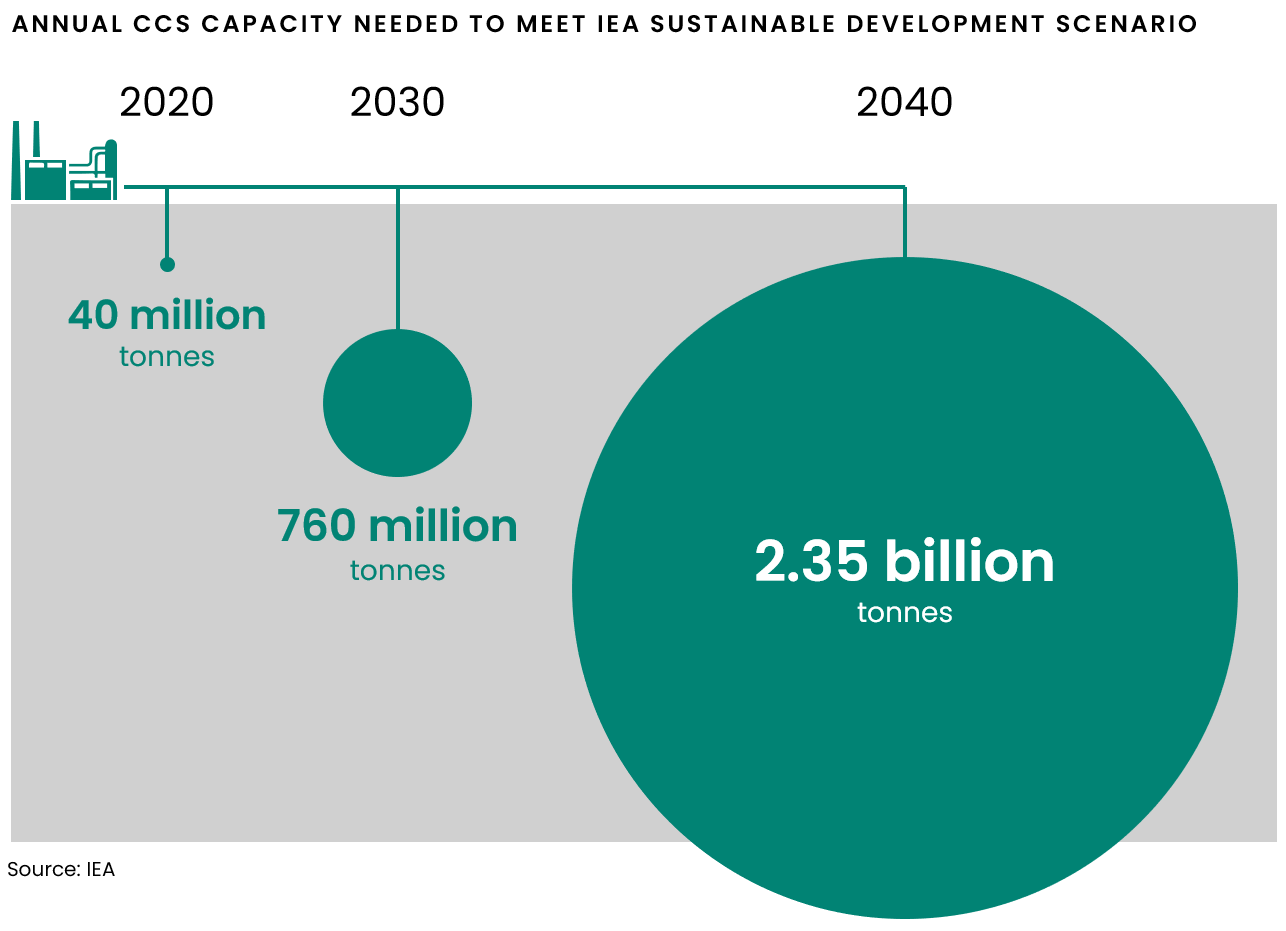In order to meet emissions goals made under the Paris Agreement, scientists agree that carbon capture, use and storage – CCUS – is a must. Yet it’s been on hold for many companies, who are only starting to get serious about it now. The technology to effectively capture CO2 and store it is not new, and it’s being improved in leaps and bounds, with more ways to put those emissions to use. And yet there are very few large-scale CCUS projects in the whole world. What will it require to reach scale, and what does it require to develop a CCUS project?
Boosting energy efficiency and transitioning to renewable energy is key to tackling climate change, but realistically fossil fuels, which currently supply more than 75 per cent of all primary energy, will remain essential to the world’s energy mix for some decades to come. The US’s National Petroleum Council’s 2019 study on a roadmap for at-scale deployment of CCUS in the United States summed it up neatly in its title: Meeting the Dual Challenge.

“Deployment of CCS at scale is essential to address the continued provision of fossil fuels to meet the growing demand for energy while also addressing climate change,” explains Nigel Jenvey, Global Head of Carbon Management with Gaffney-Cline, a consulting division of Baker Hughes. “Since the Paris Agreement in 2016, there’s been a lot more interest in CCUS, because it was both part of many countries’ submissions to fulfill their commitment to the goals, and companies also. The most recent IPCC (Intergovernmental Panel on Climate Change) and IEA (International Energy Agency) analysis shows that in order to achieve a sustainable development scenario and limit the worst impacts of climate change, that we keep global temperature rise below 1.5 degrees Celsius, and stresses that level of decarbonization simply cannot be achieved without CCUS. It’s an essential part of the lowest-cost path towards meeting climate targets: CCUS is vital if the world is to achieve the ambition of net-zero emissions by 2050.”
Here’s the rub: with few governments around the world putting a price on carbon emissions, a company’s incentive to develop a large-scale CCUS project is long-term corporate social responsibility, with short-term costs. The regulatory conditions around CCUS vary from jurisdiction to jurisdiction, even within nations. And, of course, the execution of any complex engineering project takes resources. But many of our customers are getting on board the CCUS train, as are governments, realizing that it’s a must if we are to successfully tackle global warming caused by CO2 in the atmosphere.
A short history of CCUS
According to the Global Carbon Capture and Storage Institute’s (GCCSI) 2019 “Global Status of CCS” report, there are 19 large-scale CCUS projects in operation around the world, most of them in the United States and involving oil and gas companies who are eager to play their part in advancing the technology and reduce their CO2 emissions.
The CCUS process was born in the 1930s , when carbon capture equipment was used to purify natural gas, hydrogen and other gas streams to reduce the costs of transportation, and the first large-scale commercial CCUS project was implemented in 1972, using the captured CO2 for commercial benefit.
Today, the technology has the potential to capture up to 50 per cent of the world’s CO2 emissions, according to ZEP(Zero Emissions Platform), the European Union’s technical adviser on CCS, which calculates that it has the ability to capture up to 90 per cent of CO2 emissions from power plants, heavy industry and refineries, the heaviest emitters.
In basic terms, the main technologies today for carbon capture separate CO2 from a gas stream, compresses it to dense-phase form, allowing it to be transported via pipeline, tanker or ship for safe storage, most often by injecting it deep into the earth in a range of geological formations, including depleted oil and gas fields and deep saline formations.
While CCUS technology is well understood, it does involve multiple different capabilities, including chemical and petroleum engineering, geology, metallurgy and construction expertise. Getting as quickly as possible to the point where the world is deploying CCUS at scale is critical and, as Jenvey says, “allows us to continue to use fossil fuels, without fossilized thinking”.
Baker Hughes is applying its broad portfolio of technologies to play a critical part in this global push. “To my knowledge, we are the only company in the world with a breadth of offerings along the entire value chain of CCUS,” says Allyson Anderson Book, Vice President, Energy Transition with Baker Hughes. “We have carbon capture, use and storage technology, as well as detection and mitigation, available off the shelf right now.”
One way to look at CCUS is “a sort of circularity of CO2,” adds Anderson Book. “When you produce oil and gas, you’re pulling out sequestered carbon, then putting it through a process and combustion cycle. If you capture the CO2 off the backend and put that back into a formation beneath the subsurface, you’ve got the value of the energy without the emissions byproduct from burning it. So, something that was pulled out of the ground gets to go back into the ground, creating a closed loop.”
Jenvey says it’s critical for governments to ensure there are the right policy frameworks in place to give industry the business models and confidence to invest in CCUS projects. That in turn will help advance the public’s understanding that it is a safe and reliable technology to help reduce CO2 in the atmosphere. “And that investment will also enable continued research, development and demonstration of new CCUS technologies to reduce costs, improve performance and increase scale,” he adds.

Uncovering the potential
Around the world, major research projects continue to refine carbon capture, use and storage technologies, as well as delivering solutions for emissions reduction.
Gianluca Di Federico, an energy transition and carbon capture strategist for Baker Hughes, based in Frankfurt, says the company is active in both addressing short-term challenges of energy transition and on filling the future technology gaps. “We are making sure our customers have the equipment that enables them to be more efficient and emit less CO2 than traditional operations,” he says. “Our solutions span from making more efficient gas turbines and recovering excess energy, all the way to an effective monetization of future energy assets.”
For carbon capture, Di Federico explains, Baker Hughes focuses on making sure the process itself is sustainable. “We use CAP, Chilled Ammonia Process, to remove carbon dioxide from the flue gas. CAP’s solvent is stable, not susceptible to contaminants, is widely available, easily procured, and safe.”
Jessica Raines is a geoscientist and global discipline lead for CCUS in Reservoir Technology Services at Baker Hughes. “I’m excited to see CCUS projects increasing exponentially globally because CCUS is certainly near and dear to my heart – it’s really the number one solution for industry to address the global climate challenge and to mitigate CO2 emissions as we diversify our energy portfolio,” she says. “And there are some industrial processes – such as cement, steel and chemicals – that are hard to decarbonize.”
Modeling plume behavior – how CO2 that’s been injected for storage will act once it’s deep beneath the subsurface – is critical for ensuring the integrity of the project over the long term. “For any CCUS project, you have to create predictive models to estimate, with a fair degree of precision, where your plume is going to migrate,” she explains. “It requires a suite of tools and datasets to properly characterize your anticipated reservoir.”
Avoiding unintended migration of the CO2 plume is key, and modelling helps manage risks of this, whether through induced seismicity and unintended fault activation – human-caused minor earthquakes. Any CCUS project of course has to comply with a multitude of regulatory obligations, and robust 4D forward models of CO2 storage scenarios can shorten the time a project needs to be monitored after an injection site is closed.

There is also extensive research going into making monitoring, reporting and verification (MRV) of CO2 plumes more efficient and low-cost, another advance that will help CCUS be deployed at scale.
“CCUS is the solution that allows our customers to continue to have an environmentally sound, net-neutral production of oil and gas,” says Anderson Book. “We also want to apply CCUS to other CO2-emitting industrialized processes, so they can get to net-zero and potentially net-negative CO2 emissions. CCUS is a critical component of where we’re going in our energy and industrial transition.”
For more information about Baker Hughes and CCUS, visit our capabilities page here.
Energy Forward Stories
Sign up to stay up to date on the latest innovations and people shaping the future of our industry.




